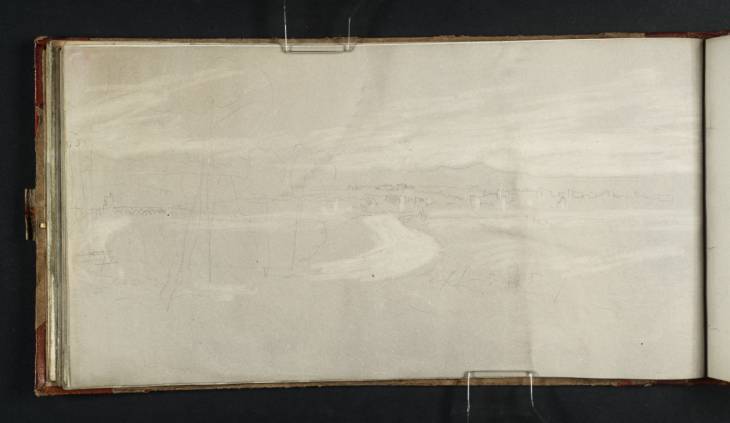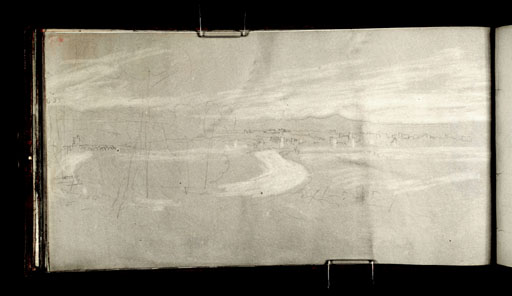Joseph Mallord William Turner The Tiber and the Ponte Molle, Rome, from the Villa Madama on Monte Mario 1819
Image 1 of 2
Joseph Mallord William Turner,
The Tiber and the Ponte Molle, Rome, from the Villa Madama on Monte Mario
1819
Joseph Mallord William Turner 1775–1851
Folio 28 Verso:
The Tiber and the Ponte Molle, Rome, from the Villa Madama on Monte Mario 1819
D16444
Turner Bequest CXC 33 a
Turner Bequest CXC 33 a
Pencil and grey watercolour wash on white wove paper, 130 x 255 mm
Accepted by the nation as part of the Turner Bequest 1856
References
1909
A.J. Finberg, A Complete Inventory of the Drawings of the Turner Bequest, London 1909, vol.I, p.566, as ‘View of river, with bridge (? Ponte Molle) on left.’.
Some of the most famous panoramas of Rome could be seen from the heights of Monte Mario, a hill to the north of the city. This sketch depicts the view from the Villa Madama, a sixteenth-century estate built for the Medici family on the eastern slopes, famous for its garden loggia designed by Raphael. The central focus of the composition is the dramatic oxbow curve of the River Tiber as it loops towards the city on the right. The bridge visible on the far left-hand side is the Ponte Molle, also known as the Ponte Milvio. This crossing carried the Via Flaminia across the Tiber into Rome and hence was the entry and exit point for British tourists to and from the city during the nineteenth century. Famous as the site of the deciding battle between Emperors Constantine and Maxentius in 312 AD, the bridge is recognisable from the four central arches spanning the river (there were also two smaller arches at either end not clearly visible from a distance) and an entrance tower on the northern end (left) which had been rebuilt in 1805.1 As a young man, Turner had made a number of watercolour copies of images of the bridge with his contemporary, Thomas Girtin for Dr Monro’s Album of Italian Views 1794–6 (see Turner Bequest CCCLXXIII 30–32; Tate D36443–D36445), and detailed studies from the 1819 tour can be found on folios 53–4 and 59–60 (D16475–D16476 and D16484–D16485; Turner Bequest CXC 59–60 and 67–8). Like many drawings within this sketchbook, the composition has been executed over a washed grey background. Turner has created areas of pale highlights by lifting or rubbing through to the white paper beneath, principally to delineate the twisting course of the river and the lightness of the sky above the dark horizon of the mountains.
Turner made a large number of sketches repeating related views from the Villa Madama and Monte Mario, see the St Peter’s sketchbook (Tate D16174–D16177; Turner Bequest CLXXXVIII 9a–11), and the Roman C. Studies sketchbook (Tate D16342, D16350, D16352, D16377 and D16391; Turner Bequest CLXXXIX 16, 24, 26, 48 and 60). The composition is also very similar to James Hakewill’s drawing of the same subject, View of the Ponte Molle and the Tiber, looking across the Campagna to the Sabine Mountains 1816.2 A further view which depicts the dome of St Peter’s from the terrace of the Villa Mellini on Monte Mario can be found on folio 6 (D16481; Turner Bequest CXC 64). The visual motif of the sweeping bend of river is also repeated in a later oil study, Hill Town on the Edge of the Campagna, ?1828 (Tate, N05526).3
Nicola Moorby
June 2009
For a detailed sketch of the bridge prior to 1805 see William Marlow (1740–1813), Ponte Molle, pencil on paper, Tate T09173.
Tony Cubberley and Luke Herrmann, Twilight of the Grand Tour: A catalogue of the drawings by James Hakewill inthe British School at Rome Library, Rome 1992, p.185. no.3.4, reproduced.
How to cite
Nicola Moorby, ‘The Tiber and the Ponte Molle, Rome, from the Villa Madama on Monte Mario 1819 by Joseph Mallord William Turner’, catalogue entry, June 2009, in David Blayney Brown (ed.), J.M.W. Turner: Sketchbooks, Drawings and Watercolours, Tate Research Publication, December 2012, https://www


